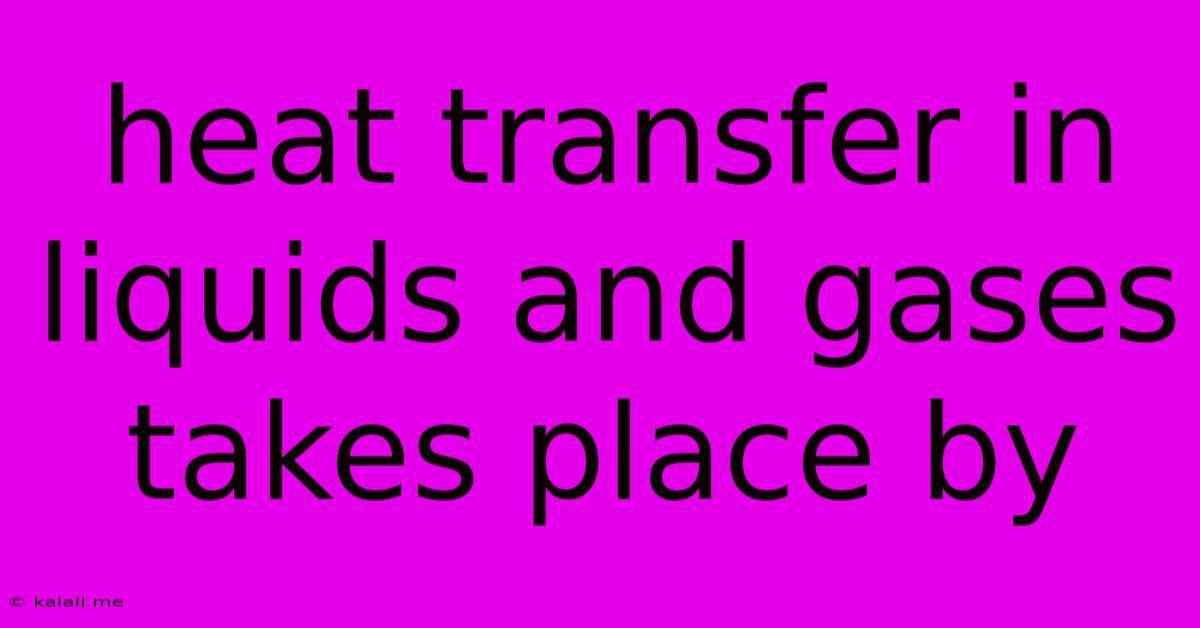Heat Transfer In Liquids And Gases Takes Place By
Kalali
Jun 14, 2025 · 3 min read

Table of Contents
Heat Transfer in Liquids and Gases: Convection Explained
Heat transfer is a fundamental concept in physics, describing the movement of thermal energy from a hotter region to a colder one. While conduction involves direct transfer through a material, and radiation utilizes electromagnetic waves, the dominant mode of heat transfer in fluids (liquids and gases) is convection. This article will delve into the mechanisms of convective heat transfer, exploring its types and the factors influencing its efficiency.
Convection, unlike conduction, involves the movement of the fluid itself. This movement transports heat energy from one location to another. Think of a pot of boiling water: the heated water at the bottom rises, while cooler water from the top sinks to replace it, creating a cycle of movement. This is precisely what convective heat transfer is all about. This cyclical movement is driven by density differences arising from temperature variations within the fluid. Hotter fluid is less dense and rises, while cooler, denser fluid sinks. This process continues until a thermal equilibrium is reached, or the heat source is removed.
Two Main Types of Convection:
Convective heat transfer is broadly classified into two main types:
1. Natural Convection (Free Convection): This occurs due to density differences caused by temperature variations within the fluid itself. No external force is applied; the movement is driven solely by buoyancy forces. Examples include:
- The rising of warm air above a radiator.
- The circulation of water in a lake heated by the sun.
- The formation of sea breezes, driven by temperature differences between land and sea.
2. Forced Convection: In this type, an external force, such as a pump, fan, or wind, is used to enhance the fluid's movement and accelerate the rate of heat transfer. This external force overcomes the limitations of natural convection and significantly increases the efficiency of heat transfer. Examples include:
- A car's radiator fan, which circulates air to cool the engine.
- The cooling system in a computer, utilizing fans to dissipate heat from the processor.
- Air conditioning systems, which use fans to circulate cool air.
Factors Affecting Convective Heat Transfer:
Several factors influence the rate of convective heat transfer:
- Temperature Difference: A larger temperature difference between the heat source and the fluid leads to a faster rate of heat transfer.
- Fluid Properties: The properties of the fluid, such as its density, viscosity, thermal conductivity, and specific heat capacity, significantly impact the efficiency of convection. For example, a fluid with higher thermal conductivity will transfer heat more efficiently.
- Fluid Velocity: In forced convection, higher fluid velocity generally results in a faster rate of heat transfer.
- Surface Area: A larger surface area in contact with the fluid will allow for greater heat transfer.
- Geometry: The shape and orientation of the surface also affect the flow patterns and, consequently, the rate of heat transfer.
Applications of Convective Heat Transfer:
Convective heat transfer is ubiquitous in numerous applications, including:
- HVAC Systems: Heating, ventilation, and air conditioning systems rely heavily on convection to distribute heated or cooled air throughout a building.
- Power Plants: Convection plays a crucial role in cooling power plant components and transferring heat from the fuel source to the working fluid.
- Electronic Cooling: Convection is essential for cooling electronic devices, preventing overheating and ensuring their proper functioning.
- Weather Patterns: Convection drives many weather phenomena, such as thunderstorms, sea breezes, and the formation of clouds.
In conclusion, convection is a critical mode of heat transfer in liquids and gases, driven by fluid movement and significantly impacted by various factors. Understanding the principles of convection is vital in designing efficient heating and cooling systems and analyzing numerous natural and engineering phenomena. The distinction between natural and forced convection is crucial for optimizing heat transfer in various applications.
Latest Posts
Latest Posts
-
Which Of The Following Is True Of The Mughal Empire
Jun 15, 2025
-
Syllabus Of Gate Exam For Ece
Jun 15, 2025
-
What Is The Human Body Resistance
Jun 15, 2025
-
Elements In Group 3 12 Are Called
Jun 15, 2025
-
Burning A Candle Is A Chemical Or Physical Change
Jun 15, 2025
Related Post
Thank you for visiting our website which covers about Heat Transfer In Liquids And Gases Takes Place By . We hope the information provided has been useful to you. Feel free to contact us if you have any questions or need further assistance. See you next time and don't miss to bookmark.